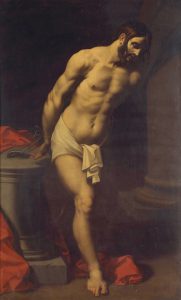
Christ at the Column
Oil on canvas, 196.9 x 119.4 cm
Presented by Sir James McBain, 1883
National Gallery of Victoria (p.308.10-1)
This canvas was presented to Melbourne in 1883, with considerable fanfare, as an original work by famed Italian Baroque painter Guido Reni.
It came with an impressive array of supporting testimonials, including a glowing description of it (c.1823) by Baron Forbin Jansen, a former director of the Louvre, as “a true work of Guido Reni and one of the most beautiful of that great master” (documents appended to the notice of acquisition in the gallery’s annual report for 1882). By 1894, however, the work was catalogued more cautiously only as attributed to Reni – a description maintained in 1905 and subsequent NGV catalogues through to 1961.
By 1973, when Ursula Hoff’s scholarly catalogue of the “before 1800” NGV collection appeared, the painting had been demoted further to “after Guido Reni,” and it was eventually omitted altogether from her revised edition published in 1995, implying a 19th-century date. It is now listed by the NGV with the attribution noted above, the early 1820s testimonial of Baron Jansen obviously providing a terminus ante quem (in other words, it must have been painted by c.1823).
The relationship with Seghers appears to be based on the similarity of Christ to the central figure in the engraving of the same subject by Lucas Vosterman (1595-1675; Flemish) after Seghers, a Flemish follower of Caravaggio’s style who worked in Italy from 1613, returning to Antwerp in 1620 to lead a successful career for the remainder of his life.
The donor of the present work, Sir James McBain (1828-92), was a Scot who migrated to Melbourne in 1853, and became a prominent banker and politician. He was an NGV Trustee, and president of the executive commission for the 1888 Centennial Exhibition. He evidently acquired it from a Dr G.D.Waite, a British dental surgeon, who lent the picture to the NGV in 1876 (as a Reni), and subsequently wrote a testimonial to its excellence (1877; also quoted in the NGV’s 1882 annual report).
For another pre-Felton painting associated with Reni, see also Unknown (17C Italian) after Reni (?) Repentance of St Peter {1889} NGV [PA] ; and for further comments on the fluctuations in Reni’s posthumous reputation, see linked artist entry.
Refs.
AR 1882, pp.37 (Schedule III: as by Reni) and pp.38-9 (documentation as noted); NGV 1894, p.122 (V.Buvelot Gallery, 7th bay, no.3: attrib.to Reni); NGV 1905, p.138 (V.Buvelot Gallery, 4th bay, no.3: attrib.to Reni)
Excerpts from the testimonials by Baron Janssen and Dr Waite were reprinted in AR 1882, as noted above. See also NGV 1943, cat.515 (as attributed to Reni); NGV 1973, p.122 (as “after Guido Reni”); Hoff (1995), p.xx (list of attributions altered since 1973); and Dean European paintings of the 19th and early 20th centuries (1995), p.120 (as a 19th-century work previously attributed to Reni)
For Seghers, see e.g. Bénézit 12, pp.939-40 and AKL 102 (2019), pp.494-95; and for the Vorsterman engraving, see e.g. https://www.nationalgalleries.org/art-and-artists/151005/christ-column (with thanks to Carl Villis for his advice on this reference). For other NGV works by or after Reni, see Hoff (1995), pp.236-7, and the gallery’s current online catalogue. For comments on the fluctuations in Reni’s posthumous reputation, see linked artist entry.
For McBain, see http://adb.anu.edu.au/biography/macbain-sir-james-4063 (biography by J.Ann Hone, from ADB vol.5, 1974). George Derby Waite (1804-80) was a noted dentist whose obituary appeared in the British Medical Journal in October 1880: see https://www.bmj.com/content/2/1032/607.2 (this and other websites noted accessed 28 Jan.2021). McBain presumably acquired the present painting sometime between 1877 and 1880

